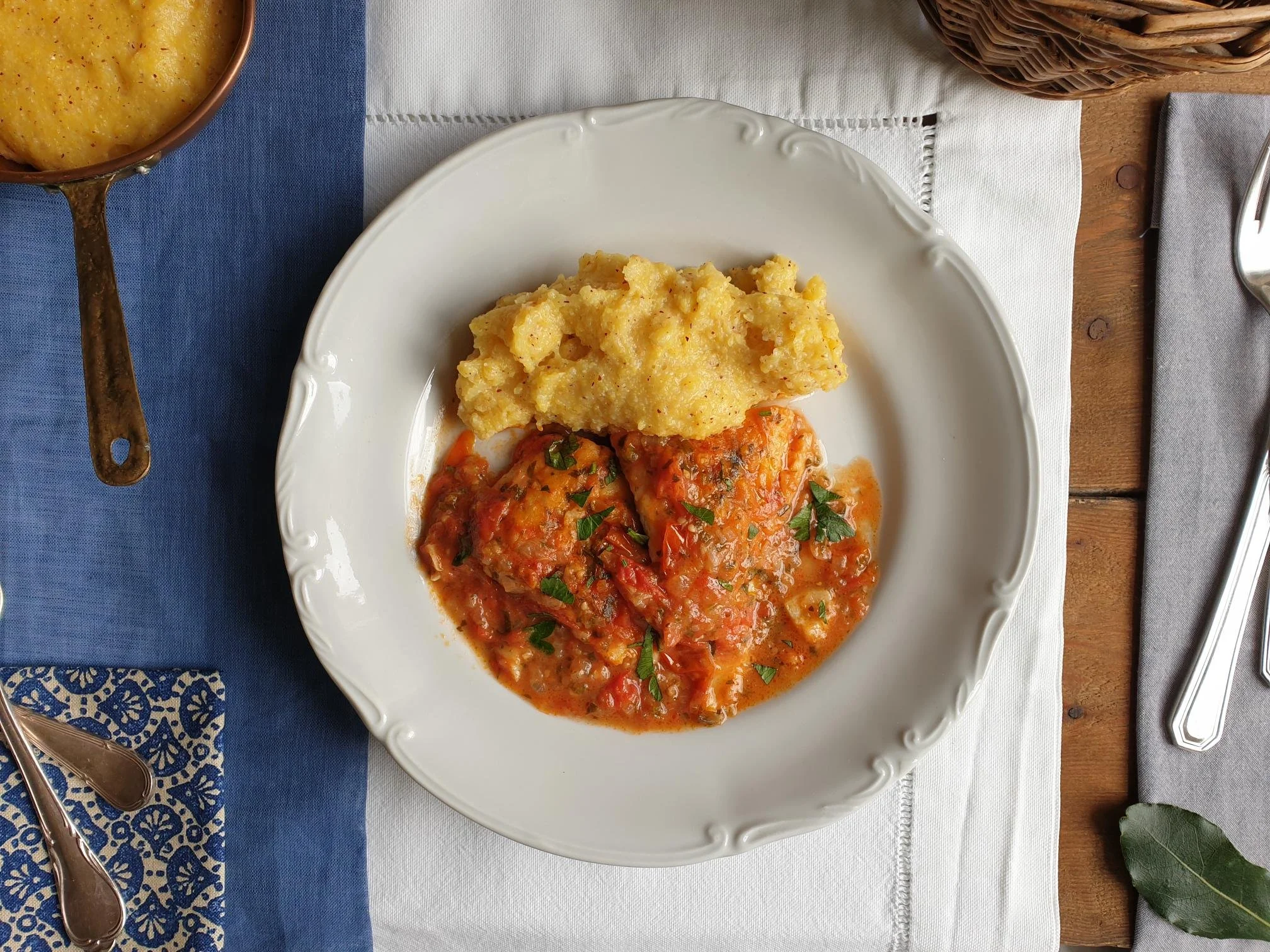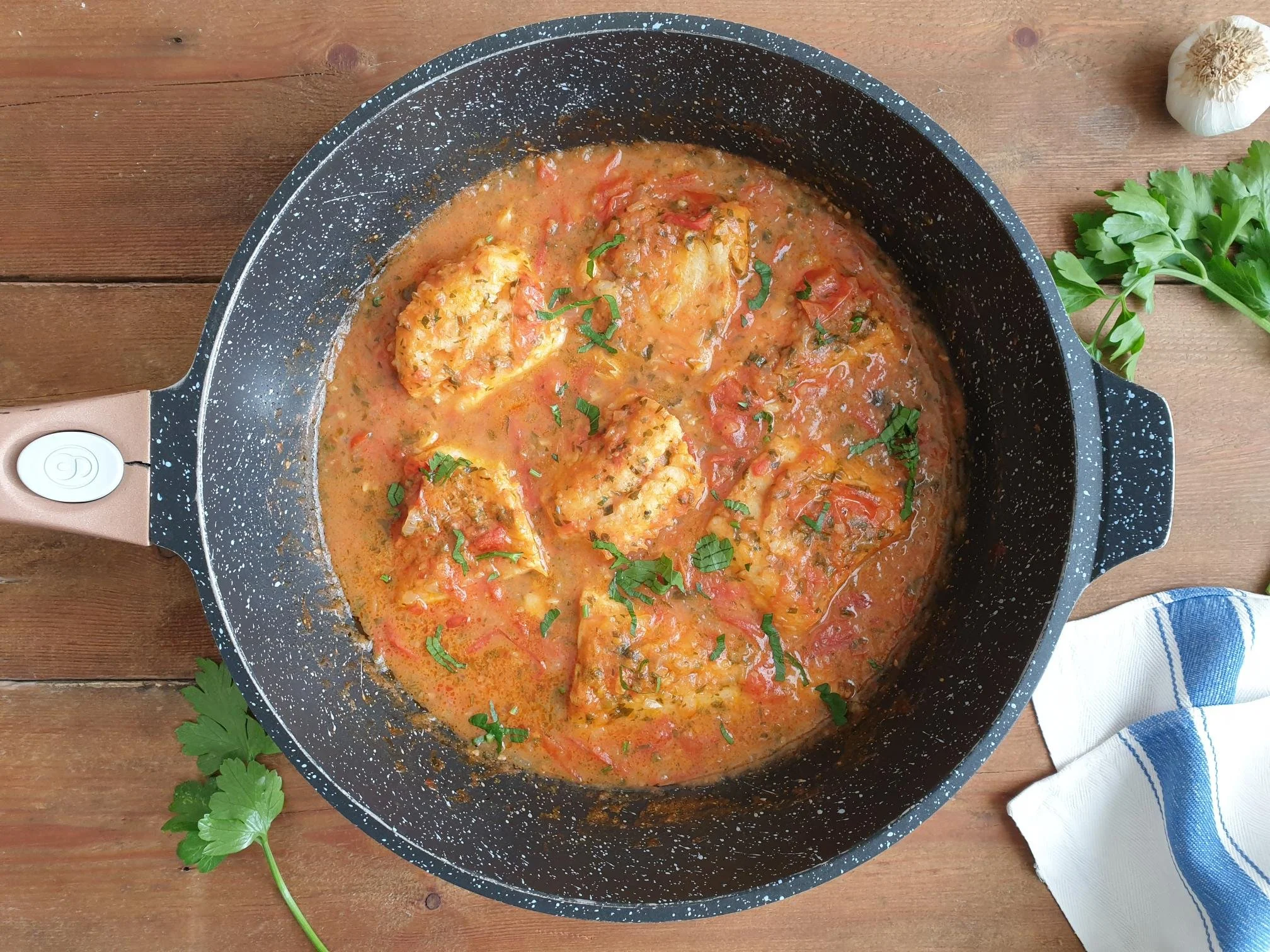Salted Cod in tomato sauce Istrian Recipe
This main, fish based dish is absolutely delicious and very special! It is rustic but delicate and elegant at the same time - cod is cooked in a simple tomato sauce enriched with onions, garlic, and fresh parsley. It is very easy to make but it does require a bit of organization and planning ahead since it is traditionally prepared with dried stockfish or salted cod that needs to be soaked and hydrated, although in this recipe you have the option to use fresh cod or similar.
This recipe is a real classic holiday and festive dish in Slovenian Istra, and holds a very special place among the locals. Dried stockfish was once a food for the poor but nowadays is a staple dish and considered a delicacy taking central stage on household tables during Christmas and Easter as it is cooked on holy days during the fasting from meat.
Dried stockfish was introduced in Istria in 15th century from Venetian cuisine, and this should not be surprising since the Venetians established a monopoly in the Adriatic Sea.
The origins of this fish, however, is far away from being local dish. It can be traced to the extreme north of Norway, to the Lofoten Islands where the Vikings, most probably the earliest inhabitants of the area, had to find a solution to the perpetual problem of hunger. They fished enormous cod shoals, then they dried the headed and gutted fish in the strong winds of the north, hanging them by their tails, the fish turned as hard as a plank of wood and it would last for a very, very long time.
This dried fish eventually started to be sold by the Norwegians to the rest of Europe, sometime in the eleven century. Gastronomically speaking, and perhaps surprisingly, dried stockfish has not been particularly well appreciated by the Scandinavians. On the contrary, in the Mediterranean countries, stockfish became an elevated dish, it was highly valued, and much more appreciated.
The biggest consumers of dry cod, just to mention a few, are Italy, Spain, Portugal, Brazil, West Africa, Caribbean, and many other countries.
Local people back home, on the Slovenian coast, are very traditional and conservative when it comes to the choice of the ingredients and cooking, therefore the use of dried stockfish would be the first choice to prepare this dish. The use of less traditional salted pieces of cod would be the second choice influenced mainly by simplicity, practicality and speed, and this is the type of cod I I use for this recipe.
In the recipe description below I am also giving you the option to use fresh cod or a similar fish, if you have difficulty finding dried stockfish, salted cod or pre-soaked cod, or simply prefer to use fresh fish instead.
Here, in the United Kingdom, where I currently live, you can find and buy dried stockfish or salted cod (sold vacuum packed) in Italian delicatessen shops especially around Christmas and Easter or alternatively order it from your trusted fishmonger or from an on-line specialist shop.
I am sharing here this very special family festive recipe in honour of my father, who very sadly is no longer with us, and who absolutely adored preparing and enjoying this dish.
At the start of Christmas season, my father would buy dried stockfish, soaked it, cooked it, removed the skin and all the bones to be left with bite size pieces that would get vacuum packed and I would take the pack on the plane back to the UK...
Ingredients
500g salted cod or about 800g of already pre-soaked cod (soaked and rehydrated cod almost doubles its original weight) Both varieties are sold vacuum packed in form of fillets with no bones.
(can use about 800g of fresh cod fillets or similar like haddock or pollock instead)
Whole stockfish (unsalted, dry cod) is traditionally used for this recipe.
white flour (for coating the fish)
2 Tbsp extra virgin oil
1 medium onion (about 140g) finely chopped
1 clove of garlic, peeled and crushed
1 handful of fresh flat leaf parsley (about 12g)
250g plum or other types of tomatoes (when in season), quartered or chopped. Use tomato passata, tinned chopped or plum tomatoes as alternative.
sea salt, if needed
Method
Serves 4
How you start this recipe will really depend on what type of cod you have.
1. If you have salted cod (I used this type for the recipe) first you need to rinse well the salted cod under very cold running water. Place rinsed cod in an airtight container, fill it completely with freezing cold water, and with some ice, if you have it, so the fillets are completely submerged. Close the lid and put the container in the fridge. Change the water after 24 hours and place in the fridge for another day. After 48 hours, the cod will be completely soaked. Remove the cod from the container, rinse well with cold water and tap dry with kitchen paper. Cut the fillet in portion size.
2. You can buy (a bit trickier to find, at least in the United Kingdom) already soaked and rehydrated cod. In this case just rinse with running cold water, tap dry and cut in portion size.
3. You can simply use fresh cod or similar like haddock or pollock fillets and cut it into portion size.
4. You can buy a whole dried stockfish. This could prove the trickiest option as the stock fish might be quite long and you need quite a big stock pot to fit it in, fill completely with very cold water and soak for at least 3 days, changing the water every day. If you do not have a very big pot to fit the whole stockfish you can use a smaller pot, like a regular 5 litre stock pot, and then place the stockfish in a pot, half of it will probably stick out, and half will be submerged in the water. Soak the submerged part of stockfish for 24 hours and after this time the soaked part of the stockfish will get soft enough to bend, which will allow you to bend it in a such a way for the whole stockfish to be completely submerged into the water in order to get properly rehydrated.
No need for rinsing as the dried stockfish is not salted. Soaked and rehydrated cod needs then to be cooked until tender, for about 1 hour or just over. When is cooked take the skin off and remove all the bones. You are left with portion size or smaller bite size piece ready to be used for this recipe.
Very lightly coat the pieces of cod in flour and shake off the excess.
Place oil in a pan (the pan should be big enough so all the pieces of cod are nicely tucked next to each other and do not overlap).
Add finely chopped onions, crashed garlic and sauté very gently until soft.
Place chopped tomatoes or passata in a pan and cook further for about 10 minutes stirring occasionally. If using fresh tomatoes make sure they are soft and use the back of a fork to squash a bit.
Place cod pieces in a tomato sauce, add finely chopped parsley and enough water to almost cover the cod fillets. If using fresh cod add the water half way up as it cooks quicker.
Partially cover with the lid and on a gentle heat cook for about 40 minutes, shaking the pan now and again. If using fresh cod the cooking time will be slightly reduced.
After this time you should end up with the velvety sauce that is not too thick nor too thin and liquidy.
If the the sauce, however, is too thin sprinkle a bit of flour or breadcrumbs and cook further briefly until you get the desired consistency.
Contrary, if the sauce gets too thick dilute it with a bit of water.
Taste and adjust the seasoning with sea salt especially if preparing this dish using dried stockfish or fresh fish. If using salted cod you will most probably not need any extra sea salt for seasoning, as although the fish gets soaked and desalinated, the fish still retains some of the salt, and this gets released during cooking.
Just a thought
This dish is traditionally served with soft cooked polenta or some crunchy bread to soak up the sauce.
Salted cod in tomato sauce can also be eaten with the pasta of your choice or it can be used as a base to make a risotto.
This dish will keep well in the fridge for few days in an airtight container and is suitable for freezing.
Wine suggestion
Pinot Bianco DOC 2020- Doro Princic






